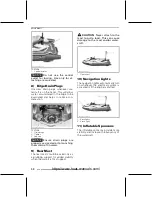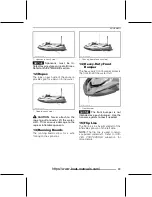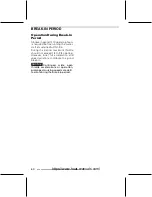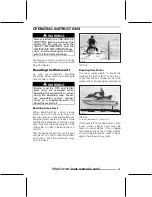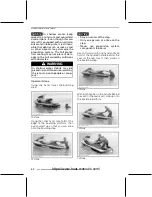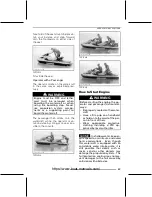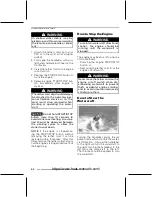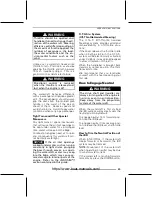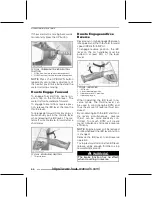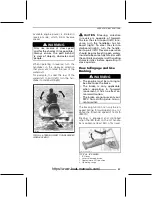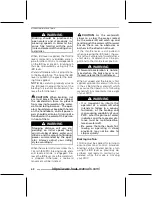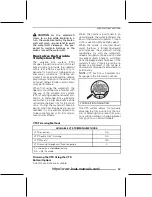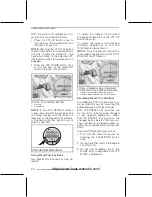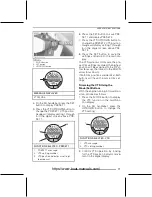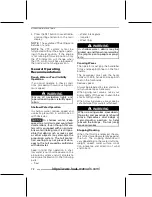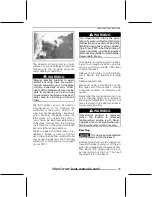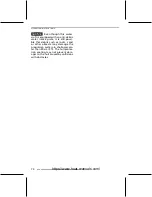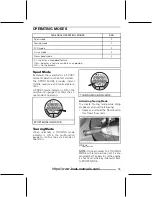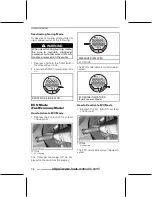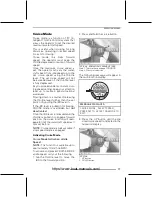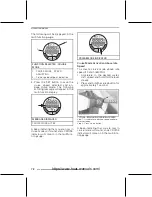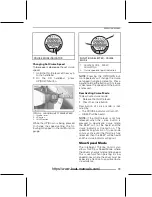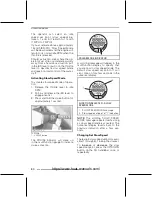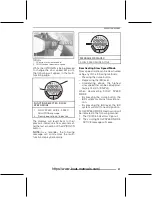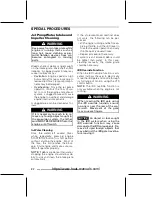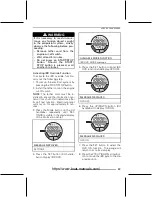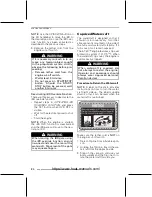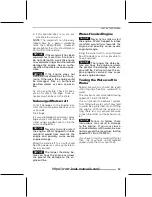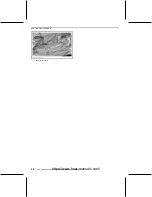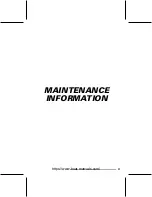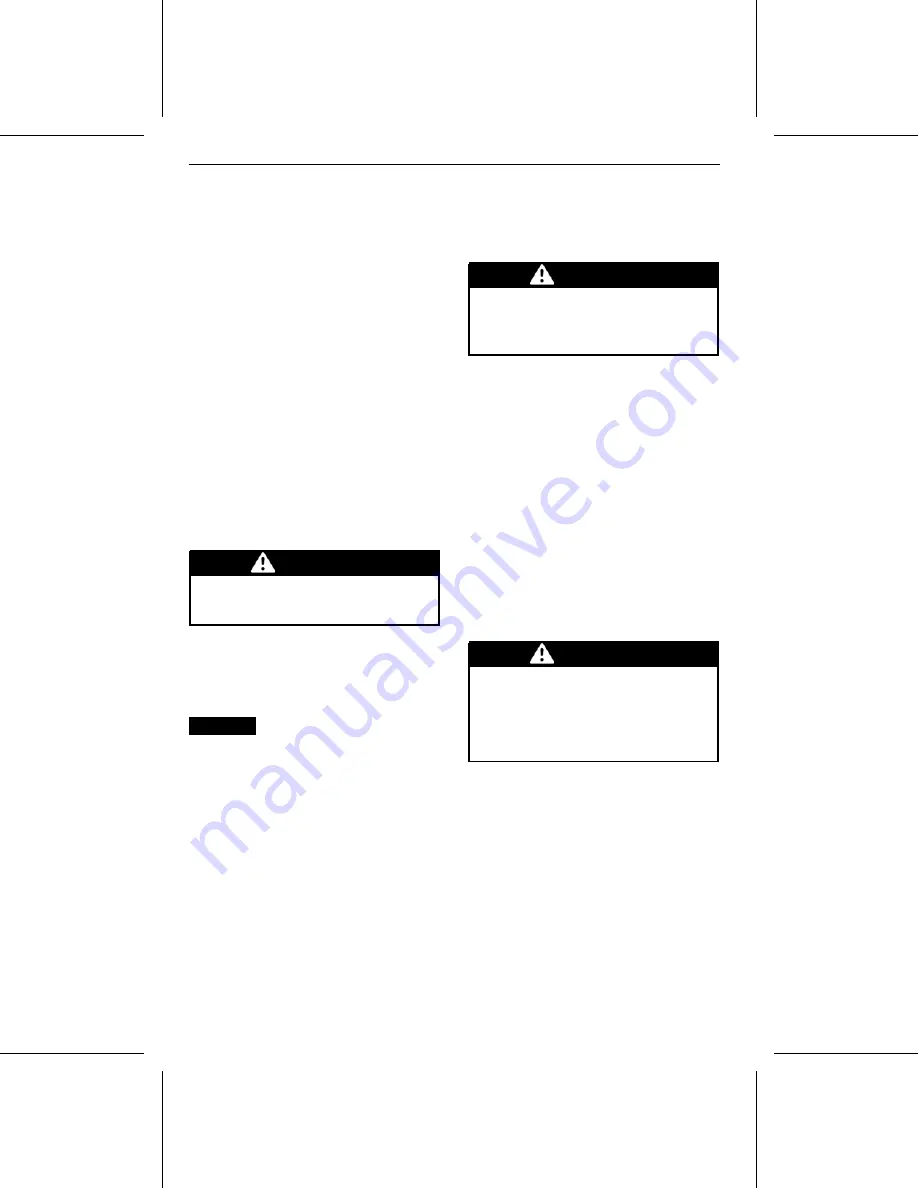
OPERATING INSTRUCTIONS
4. Press the SET button to save the de-
sired setting and return to the main
display.
NOTE:
The available VTS settings are
between 1 and 5.
NOTE:
The VTS system cannot be
fully tested without the engine operat-
ing in forward position. If the engine
is not running in forward position, only
the VTS indication will change when
the VTS control switches are pressed;
the nozzle will not change position.
General Operating
Recommendations
Rough Water or Poor Visibility
Operation
If you must operate in these condi-
tions, proceed with caution using mini-
mum speed.
WARNING
Ensure all navigation lights are
operational in poor visibility oper-
ation.
Shallow Water Operation
In shallow water, reduce speed and
use extra precaution to avoid collision
with obstacles.
NOTICE
In shallow water, keep
speed to a minimum and avoid hard
accelerations. Even though this wa-
tercraft is equipped with an anti-de-
bris water intake grate, it is still pos-
sible that debris such as rocks, sand
or other objects may damage the
propulsion system. The hull protec-
tion coating may not prevent dam-
ages to the hull caused by collisions
with obstacles.
Keep in mind that operation in shal-
low water is much more severe on the
propulsion system and will accelerate
wear (due to abrasion) to the following
parts:
– Seal
– Water intake grate
– Impeller
– Wear ring.
WARNING
In shallow water, debris may be
picked up and thrown rearward by
the jet pump onto people or prop-
erty.
Crossing Waves
The operator must grip the handlebar
firmly and keep both feet on the foot-
boards.
The passenger must grip the hand-
holds with both hands and keep both
feet on the footboards.
Reduce speed.
Always be prepared to steer and main-
tain your balance as necessary.
When going over waves, raise your
body slightly off the seat to absorb the
shocks with your legs.
When crossing wakes, always keep a
safe distance from watercraft ahead.
WARNING
When crossing wakes, slow down.
Operator and passenger(s) should
brace themselves and adopt a
semi-standing position to help
absorb the bumps. Do not jump
waves or wakes.
Stopping/Docking
When the throttle is released, the wa-
tercraft is slowed by water drag against
the hull. The stopping distance will
vary depending on the watercraft size,
weight, speed, water surface condi-
tion, presence and direction of wind
and current.
72
______________
https://www.boat-manuals.com/
Summary of Contents for SEA-DOO Search and Rescue Series 2017
Page 9: ...SAFETY INFORMATION ________ SAFETY INFORMATION ________ 7 https www boat manuals com...
Page 39: ...WATERCRAFT INFORMATION _______________ 37 https www boat manuals com...
Page 89: ...MAINTENANCE INFORMATION _______________ 87 https www boat manuals com...
Page 115: ...TECHNICAL INFORMATION ______________ 113 https www boat manuals com...
Page 120: ...SPECIFICATIONS This page is intentionally blank 118 ______________ https www boat manuals com...
Page 121: ...TROUBLESHOOTING ______________ 119 https www boat manuals com...
Page 131: ...WARRANTY ______________ 129 https www boat manuals com...
Page 153: ...CUSTOMER INFORMATION ______________ 151 https www boat manuals com...
Page 157: ...CHANGE OF ADDRESS OWNERSHIP ______________ 155 https www boat manuals com...
Page 159: ...CHANGE OF ADDRESS OWNERSHIP NOTES ______________ 157 https www boat manuals com...
Page 160: ...CHANGE OF ADDRESS OWNERSHIP NOTES 158 ______________ https www boat manuals com...
Page 161: ...CHANGE OF ADDRESS OWNERSHIP NOTES ______________ 159 https www boat manuals com...
Page 162: ...CHANGE OF ADDRESS OWNERSHIP NOTES 160 ______________ https www boat manuals com...
Page 163: ...https www boat manuals com...

